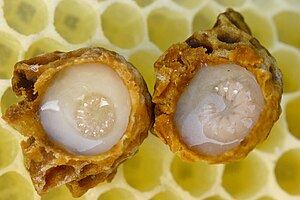Developing queen larvae surrounded by royal jelly
Royal jelly is a honey bee secretion that is used in the nutrition of larvae, as well as adult queens. It is secreted from the glands in the hypopharynx of nurse bees, and fed to all larvae in the colony, regardless of sex or caste.
During the process that a hive is creating new queens, the
workers construct special queen cells. The larvae in these cells are fed
with copious amounts of royal jelly. This type of feeding triggers the
development of queen morphology, including the fully developed ovaries needed to lay eggs.
Royal jelly is widely marketed as a dietary supplement. It is an alternative medicine that falls under the category of apitherapy. Both the European Food Safety Authority and United States Food and Drug Administration
have concluded that the current evidence does not support the claim of
health benefits, and have actively discouraged the sale and consumption
of the jelly. In the United States, the Food and Drug Administration has
taken legal action against companies that have used unfounded claims of
health benefits to market royal jelly products. There have also been
documented cases of allergic reactions, namely hives, asthma, and anaphylaxis, due to consumption of royal jelly.
Production
Royal
jelly is secreted from the glands in the heads of worker bees and is
fed to all bee larvae, whether they are destined to become drones
(males), workers (sterile females), or queens (fertile females). After
three days, the drone and worker larvae are no longer fed with royal
jelly, but queen larvae continue to be fed this special substance
throughout their development.
Composition
Royal jelly is 67% water, 12.5% protein, 11% simple sugars (monosaccharides), 6% fatty acids and 3.5% 10-hydroxy-2-decenoic acid (10-HDA). It also contains trace minerals, antibacterial and antibiotic components, pantothenic acid (vitamin B5), pyridoxine (vitamin B6) and trace amounts of vitamin C, but none of the fat-soluble vitamins: A, D, E or K.
Proteins
Major royal jelly proteins (MRJPs) are a family of proteins secreted
by honey bees. The family consists of nine proteins, of which MRJP1
(also called royalactin), MRJP2, MRJP3, MRJP4, and MRJP5 are present in
the royal jelly secreted by worker bees. MRJP1 is the most abundant, and largest in size. The five proteins constitute 83–90% of the total proteins in royal jelly. Royal jelly has been used in traditional medicine since ancient times, and the MRJPs are shown to be the main medicinal components. They are synthesised by a family of nine genes (mrjp genes), which are in turn members of the yellow family of genes such as in the fruitfly (Drosophila)
and bacteria. They are attributed to be involved in differential
development of queen larva and worker larvae, thus establishing division of labour in the bee colony.
Epigenetic effects
The honey bee queens and workers represent one of the most striking examples of environmentally controlled phenotypic polymorphism.
Even if two larvae had identical DNA, one raised to be a worker, the
other a queen, the two adults would be strongly differentiated across a
wide range of characteristics including anatomical and physiological
differences, longevity, and reproductive capacity.
Queens constitute the female sexual caste and have large active
ovaries, whereas female workers have only rudimentary, inactive ovaries
and are functionally sterile. The queen–worker developmental divide is
controlled epigenetically
by differential feeding with royal jelly; this appears to be due
specifically to the protein royalactin. A female larva destined to
become a queen is fed large quantities of royal jelly; this triggers a
cascade of molecular events resulting in development of a queen. It has been shown that this phenomenon is mediated by an epigenetic modification of DNA known as CpG methylation.
Silencing the expression of an enzyme that methylates DNA in newly
hatched larvae led to a royal jelly-like effect on the larval
developmental trajectory; the majority of individuals with reduced DNA
methylation levels emerged as queens with fully developed ovaries. This
finding suggests that DNA methylation in honey bees allows the expression of epigenetic information to be differentially altered by nutritional input.
Use by humans
Royal jelly is collected and sold as a dietary supplement for humans, but the European Food Safety Authority
has concluded that the current evidence does not support the claim that
consuming royal jelly will give health benefits in humans. In the United States, the Food and Drug Administration has taken legal action against companies that have used unfounded claims of health benefits to market royal jelly products.
Cultivation
Royal
jelly is harvested by stimulating colonies with movable frame hives to
produce queen bees. Royal jelly is collected from each individual queen
cell (honeycomb)
when the queen larvae are about four days old. These are the only cells
in which large amounts are deposited; when royal jelly is fed to worker
larvae, it is fed directly to them, and they consume it as it is
produced, while the cells of queen larvae are "stocked" with royal jelly
much faster than the larvae can consume it. Therefore, only in queen
cells is the harvest of royal jelly practical. A well-managed hive
during a season of 5–6 months can produce approximately 500 g of royal
jelly. Since the product is perishable, producers must have immediate
access to proper cold storage (e.g., a household refrigerator or
freezer) in which the royal jelly is stored until it is sold or conveyed
to a collection center. Sometimes honey or beeswax is added to the royal jelly, which is thought to aid its preservation.
Adverse effects
Royal jelly may cause allergic reactions in humans ranging from hives, asthma, to even fatal anaphylaxis.
The incidence of allergic side effects in people who consume royal
jelly is unknown. The risk of having an allergy to royal jelly is higher
in people who have other allergies.

